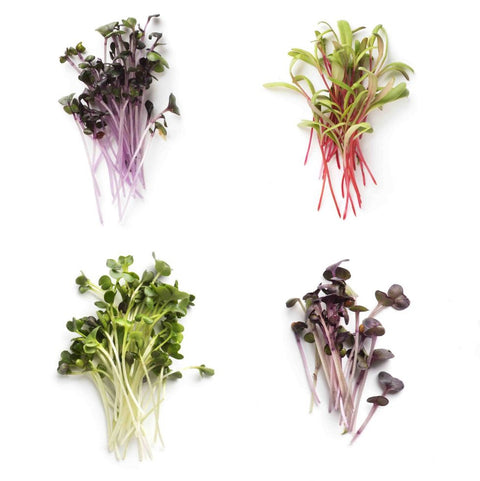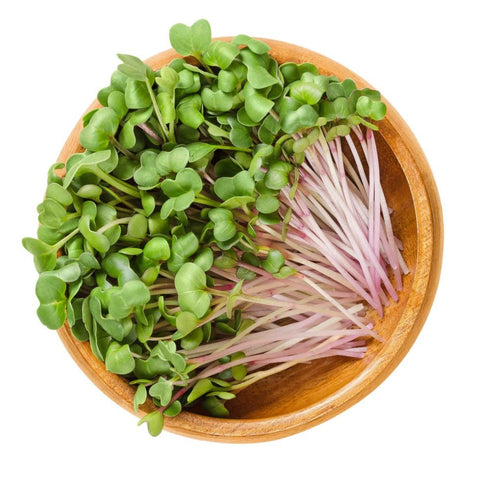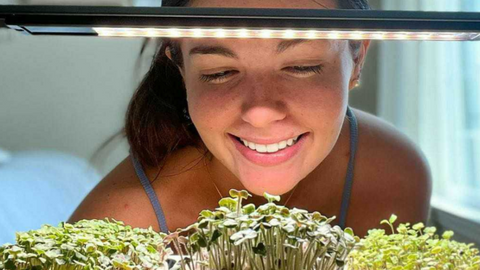Ready to green up your healthy eating routine with some small but powerful superfoods? If so, it's time to meet the microgreens!
With an increasing number of options of microgreen seeds being available these days, it's easy to feel overwhelmed by all the choices. Each type of microgreen seedling has its own distinctive flavor, color, and growth rate.
In this blog, we'll cover the main categories of microgreens to help you choose which ones are right for you, as well as provide a few recommendations on good places to start if you're new to growing microgreens.
If you’re interested in learning more about how to grow, consume, and get the most out of your microgreens, be sure to check out the links to our separate blogs.

Types of Microgreens you can Grow at Home
Microgreens are one of the most satisfying foods to grow – and the best suited to growing in small indoor spaces. They are super fast, nutritious, and flavorful – and there are hundreds of varieties to choose from. Pretty much any vegetable, grain, legume, or salad green can be grown as a microgreen, so there are a lot to consider (flavor, looks, price, timing) but we find it most useful to think about it in terms of how you’ll use them.
Microgreen Types: Which Ones Are Right For You?
Microgreens With A MILD Flavor
Mild flavors range from nutty to sweet, many with the delicate taste of larger vegetables – like carrot and cucumber. These microgreens make it easy to boost the nutrition of a meal without changing the taste too much.
Our Favorites: Alfalfa, Borage, Broccoli, Carrot, Chard, Kale
| Type | Alfalfa | Borage | Broccoli | Carrot | Chard | Kale |
|---|---|---|---|---|---|---|
| Family | Fabaceae | Boraginaceae | Brassicaceae | Apiaceae | Amaranthaceae | Brassicaceae |
| # of Days to Harvest | 6-7 days | 12-21 days | 6-14 days | 14-25 days | 7-12 days | 7-10 days |
| Pre-soak? | Yes | No | Yes | No | Yes | Yes |
Microgreens with a SPICY Flavor
There are several microgreens with deep spiciness that you can use in your hearty dishes. We love dressing our salad with mustard microgreens and topping our pizzas with arugula. We also love the rush of eating the radish straight.. but maybe we’re a bit intense.
Our Favorites: Arugula, Cress, Mustard, Radish
| Type | Arugula | Cress | Mustard | Radish |
|---|---|---|---|---|
| Family | Brassicaceae | Brassicaceae | Brassicaceae | Brassicaceae |
| # of Days to Harvest | 2-7 days | 7-12 days | 2-14 days | 7-10 days |
| Pre-soak? | No | No | No | Yes |
HERBS that can be grown as Microgreens
Most herbs can be grown as microgreens. In addition to the much shorter time to harvest (in days, not months), they are also more tender, making them better garnishes for desserts and cocktails.
Our Favorites: Anise, Basil, Cilantro, Dill, Fennel, Scallion
| Type | Anise | Basil | Cilantro | Dill | Fennel | Scallion |
|---|---|---|---|---|---|---|
| Family | Apiaceae | Lamiaceae | Apiaceae | Apiaceae | Apiaceae | Amaryllidaceae |
| # of Days to Harvest | 14-21 days | 12-20 days | 10-20 days | 7-14 days | 7-28 days | 12-21 days |
| Pre-soak? | No | No | Yes | No | Yes | Optional |
Microgreen SHOOTS that are good for snacking
Shoots are our favorite for snacking on straight – but also add a nice crisp to sandwiches and are some of the most kid-friendly varieties. They are typically bigger seeds that need to be soaked before planting. It’s not too hard, but is a tiny bit more advanced.
Our Favorites: Corn, Garbanzo, Lentil, Peas, Soy, Sunflower
| Type | Corn | Garbanzo | Lentil | Peas | Soy | Sunflower |
|---|---|---|---|---|---|---|
| Family | Poaceae | Fabaceae | Fabaceae | Fabaceae | Fabaceae | Asteraceae |
| # of Days to Harvest | 6-7 days | 7-14 days | 7-10 days | 8-14 days | 7-9 days | 10-14 days |
| Pre-soak? | Yes | Yes | No | Yes | Yes | Yes |
Best types of Microgreens for Beginners: A Microgreens List
Unless you’re a celebrity chef or way ahead of the curve, chances are you don’t know what your favorite microgreen is. There are also so many different flavors out there, we think it’s best to start with a wide range of representative flavors & textures (and ones that are also easy to grow) so you can get your footing and decide which flavors to explore further.
We think the perfect starting microgreen list is:
- Radish: Radishes show off just how flavorful microgreens can be. Compared to the radishes you know, you will find these to be immensely rich, peppery, and slightly floral.
- Lentil: While this might not be the first microgreen that comes to mind – it’s a great representative of the “shoots” family. It’s crisp with a fresh, sweet flavor and the easiest of the family to grow (doesn’t require soaking, ready in 7 days).
- Mustard: This is a super fast grower, showing its green leaves after just 2 days, and you’ll be blown away by the bold, spicy mustard flavor.
- Kale: Kale is a classic “mild” microgreen – it has a rich, nutty flavor that goes well with a broad range of dishes. Its soft texture also shows off just how tender microgreens are compared to their adult counterparts.
Want to learn more about Microgreens? Check out our other blogs on:
- What Exactly Are Microgreens Anyway?
- How Anyone Can Grow Microgreens At Home
- Benefits of MicroGreens: It’s Not The Size That Counts
- How to Use Microgreens In Your Salads, Smoothies, Snacks and More
Best Microgreens Kit For You?
If you're ready to have a go at growing microgreens yourself, then here are a few of our favorite kits:
- Best for Chefs: If you're looking to grow microgreens on your kitchen countertop, then it's hard to go past the ingarden. It's also the only option on this list with an integrated grow light, making it great for low/no light situations.
- Best For Sustainable Living: The Orta Gardens kits are made from clay in the US and come plastic-free. All of the 'consumable' parts of this kit are backyard compostable, and it's easy to find materials needed for refill. Comes in both a small and large size.
- Best for Larger Households: If you're a household of more than 3 people OR you just really love eating loads of microgreens, then you should check out the Hamama kit. The refill process is super simple, and it offers the largest growing space of any of the kits on this list.
- Best for the Design Lover: The MicroPod offers not only a sleek design, but it's also the only kit on this list that does not require any growing medium!
- Best for Small Spaces: If you live in an apartment or don't have loads of space, then check out the Urban Leaf kit. It comes with 6 seed varieties (more than any of the others) and is also compatible with a window shelf.
Learn more about all of the above kits here. No matter how you grow them, you're bound to love them, so enjoy!









I just want to thank you all Urban Leaf for all the info as I have aerogardens and was trying to find less expensive sponges&plant food which I just did with you all&purchased both as well as some micro pads for my microgreens and I’ve learned even more by just reading the inserts you have about it which encourages me even more because I’m trying to eating healthier&make better choices about what I put into my body now at at 63&having a ache here&there now 😂so my body is letting me know that I need to treat&feed it better,plus I love putting micro in my smoothies also🥦🥬🥕🥒🍎 🍓 so thank you and keep up the great work You all do to keep us all healthier 😊
Be Blessed&Have A Positive Day🌤